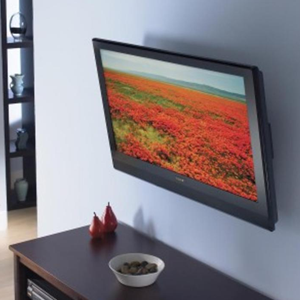TV Wall Mount Installation

TV Wall Mount Installation
One of the things that TV wall mount installation has taught me is that there are three basic types of people. There are of course many subsets of these groups, but the three main types of people are: the “DIYers”, the “Can’t Do’s” and the “Could Do’s”. The DIYers don’t need our help and they don’t want our help, unless they try to do it themselves and mess something up. The Can’t Do’s really do need our help, either because they don’t have the knowledge or the experience to do it themselves. Lastly the Could Do’s; who could do the job themselves but either don’t have time to do it themselves, or would simply rather pay someone to do it for them. No matter if you’re going to pay to have someone install the TV for you, or if you’re thinking of doing it yourself, there are a few things you should know before you get started.
Choose the right style TV mounting bracket
 There are many different types of TV mounting brackets on the market, but we’ll focus on the three most common styles. A “fixed” style TV mounting bracket is the most basic style. It’s basically just what it says it is; it fixes the TV to the wall with little to no adjustment. A fixed mount is also generally the least expensive of all the styles of TV mounting bracket.
There are many different types of TV mounting brackets on the market, but we’ll focus on the three most common styles. A “fixed” style TV mounting bracket is the most basic style. It’s basically just what it says it is; it fixes the TV to the wall with little to no adjustment. A fixed mount is also generally the least expensive of all the styles of TV mounting bracket.
A “tilt” style TV mounting bracket is the next most basic style, which basically expands on a fixed mount bracket by offering a vertical tilt adjustment. Though generally more expensive than a fixed mount, a tilt mount is usually not very expensive. A tilt mount bracket is the most popular style of TV mounting bracket because it offers a more comfortable viewing angle and glare reduction, especially when mounted above fireplaces or other fixtures.
“Full motion” mounting brackets are generally the most expensive of the three main styles of TV mounting bracket because it offers the most flexibility. In addition to a vertical tilt, a full motion bracket allows the TV to be pulled away from the wall and turned to the left or right. Full motion brackets are also sometimes referred to as “cantilever” or “arm” brackets.
Think about the layout of your room, and how you plan to use the TV once it’s mounted on the wall. I even recommend that you sit on the couch and imagine the TV is already mounted. Note how high you think the TV should be, and whether or not you’d benefit from being able to change the vertical or horizontal angle of the TV. All this information will help you choose the right style of TV bracket.
Choose the right size TV mounting bracket
The packaging and marketing information for most TV mounting brackets will claim to work with a certain range of sizes of TV. And while these size estimates are accurate 90% of the time, it’s important to know that the range of sizes they claim to fit is strictly an estimate. If you want to be certain the bracket will accommodate your TV you should compare the weight of your TV to the weight limit of the TV mounting bracket in question.
 There is also the issue of the VESA pattern or FDMI/MIS pattern. The VESA pattern is a reference to the distance (in millimeters) between the mounting points on the back of the TV. An example of a VESA pattern size would be 400×400. You’ll likely need to reference the owner’s manual or technical specs to find the pattern used on your TV. As long as the pattern falls within the sizes listed on the bracket then you should have no problems with the fit.
There is also the issue of the VESA pattern or FDMI/MIS pattern. The VESA pattern is a reference to the distance (in millimeters) between the mounting points on the back of the TV. An example of a VESA pattern size would be 400×400. You’ll likely need to reference the owner’s manual or technical specs to find the pattern used on your TV. As long as the pattern falls within the sizes listed on the bracket then you should have no problems with the fit.
Mounting surface & wall construction
It’s important to know what type of wall you’re planning to mount the TV on. You’ll want to know what the surface of the wall is made of (plaster, sheetrock/drywall, tile, paneling, etc) as well as what the construction of the inner wall is (standard wood framing, metal framing, concrete, brick, etc). This will make a difference when it comes time to start planning out and drilling holes for the anchor bolts. Wall construction may also dictate whether or not you can conceal the wiring for the TV inside the wall.
Wire concealment
Mounting a TV on the wall isn’t just about physically installing the TV; it’s also about connecting external input devices so you can actually watch the TV once it’s installed. You’ll need to decide how many devices you’re going to connect to the TV, and which types of cable each device requires. If you’re going to have the wiring concealed inside the wall, you will likely need longer cables than you would otherwise need.
You’ll also want to figure out if you need new electrical outlets installed. Building construction and safety codes dictate that it is unsafe to have the TV’s power cord or an extension cord inside the wall. It’s best to have an electrician install a live power outlet or utilize a power bridge to relocate an outlet in order to safely power your TV and maintain code compliance. You may void your homeowners insurance by running improper wiring thru the wall. Give us a call to learn more about power bridges and wire concealment. 865-264-0006
Before You Hire Someone
 As mentioned before, there’s more to installing a TV than simply mounting it to the wall. A handyman or general contractor should be very capable of installing a TV mounting bracket, but they may not know much at all about which type of cable offers the best picture quality, how to properly setup your source devices or how to program and consolidate your remote controls.
As mentioned before, there’s more to installing a TV than simply mounting it to the wall. A handyman or general contractor should be very capable of installing a TV mounting bracket, but they may not know much at all about which type of cable offers the best picture quality, how to properly setup your source devices or how to program and consolidate your remote controls.
You should also be sure that anyone you hire to do a job in your home or business is licensed, insured and certified to do the type of work you’re hiring them to do. It’s also important to choose someone who has high standards and excellent feedback. There are quite a few places online where you can verify the reputation of a company you’re considering for the job.
Google and Angie’s list are both great resources for customer feedback, and Yelp isn’t just for restaurants anymore. They have a lot of different service based categories where businesses can receive feedback. You can also check with the Better Business Bureau, but keep in mind that the BBB typically only resolves customer disputes and may not be the best resource to get a feel for general customer satisfaction. I suggest avoiding Home Advisor. Look for a blog post and accompanying video soon where I’ll explain why.
As always, if you’re feeling lost or have any questions, please feel free to give us a call. Call and we’ll come to the rescue!

 D5 Creation
D5 Creation
Comments are Closed